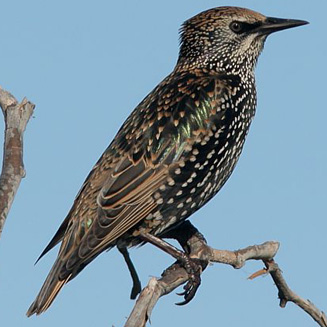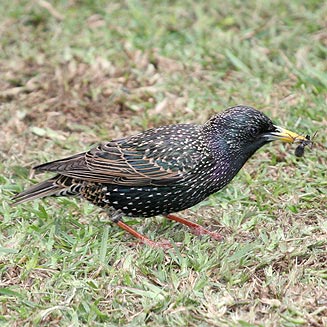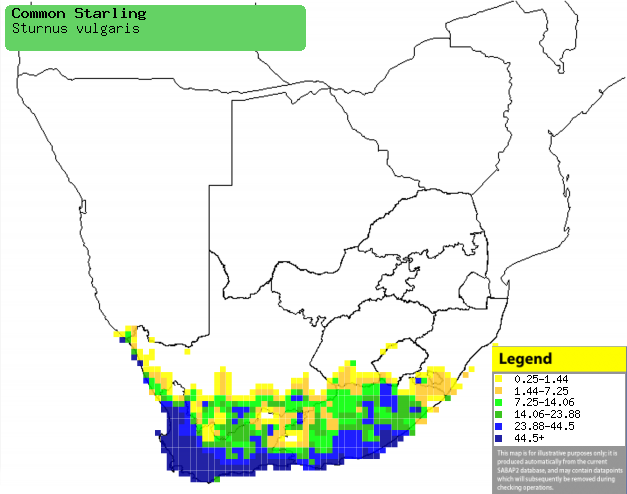|
Sturnus vulgaris (Common
starling, Eurasian starling, European starling)
Europese spreeu [Afrikaans]; Leholi (generic term for
starlings) [South Sotho]; Spreeuw [Dutch]; Étourneau sansonnet [French]; Star
[German]; Estorninho-malhado [Portuguese]
Life
> Eukaryotes >
Opisthokonta
> Metazoa (animals) >
Bilateria >
Deuterostomia > Chordata >
Craniata > Vertebrata (vertebrates) > Gnathostomata (jawed
vertebrates) > Teleostomi (teleost fish) > Osteichthyes (bony fish) > Class:
Sarcopterygii (lobe-finned
fish) > Stegocephalia (terrestrial
vertebrates) > Tetrapoda
(four-legged vertebrates) > Reptiliomorpha > Amniota >
Reptilia (reptiles) >
Romeriida > Diapsida > Archosauromorpha > Archosauria >
Dinosauria
(dinosaurs) > Saurischia > Theropoda (bipedal predatory dinosaurs) >
Coelurosauria > Maniraptora > Aves
(birds) > Order: Passeriformes
> Family: Sturnidae
 |
 |
|
Common starling,
Strandfontein Sewage Works, South Africa. [photo
Trevor Hardaker ©] |
Common starling feeding on ants, Cape Town,
Western Cape, South Africa. [photo Duncan Robertson
©] |
Distribution and habitat
Originally from Eurasia, north Africa and Japan, it was
introduced to Australia, New Zealand, North America, Argentina and South Africa,
and is now considered a serious pest to agriculture in some of these regions. It
mainly occurs in the southern half of South Africa, and is by far the most
common in urban and agricultural areas.
|
 |
|
Distribution of Common starling in southern Africa,
based on statistical smoothing of the records from first SA Bird Atlas
Project (©
Animal Demography unit, University of
Cape Town; smoothing by Birgit Erni and Francesca Little). Colours range
from dark blue (most common) through to yellow (least common).
See here for the latest distribution
from the SABAP2. |
Predators and parasites
It has been recorded as prey of
Falco peregrinus
(Peregrine falcon).
Brood parasites
It has been recorded as host of the
Lesser honeyguide.
Food
It mainly eats arthropods supplemented with fruit, seeds
and nectar, doing most of its foraging on the ground, plucking food items up or
probing the soil for underground prey. The following food items have been recorded
in its diet:
- Animals
- arthropods
- crustaceans
- small vertebrates
- Plants
- fruit
- figs
- cherries
- guavas
- grapes
- pears
- plums
- seeds
- wheat
- barley
- sorghum
- corn
- nectar
- Miscellaneous
- dog pellets
- scraps of human food
Breeding
- The nest is mainly built by the female, consisting of a large structure
made of twigs, dry grass, string and other rubbish, lined with finer
material such as paper, grass, wool, feathers or hair. It is typically
placed in a hole in a building or tree, but it may also put it on the ground
or even in an offshore shipwreck.
- Egg-laying season is from September-December.
- It lays 2-6 eggs, which are incubated for about 15 days by both sexes,
although the female always solely incubates at night.
- The chicks are brooded by the female and fed by both parents, leaving
the nest after about 21 days and becoming independent about 5 days later.
Threats
Undesirable alien in southern Africa, although it is not as
damaging to agriculture in comparison to the USA.
References
-
Hockey PAR, Dean WRJ and Ryan PG 2005. Roberts
- Birds of southern Africa, VIIth ed. The Trustees of the John Voelcker
Bird Book Fund, Cape Town.
|
